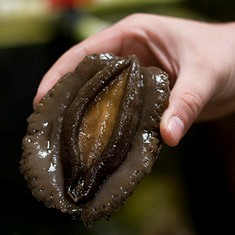 balone farmers in southeasterly Fujian are seeking government support after a tumble in prices this summer. Ironically, government may also be the source of falling prices. Abalone farmers in Dongshan, a small city between Xiamen and Shantou, say that abalone prices have fallen from an average RMB 100 (USD 16.28, EUR 12.53) per kilo to RMB 50 (USD 8.14, EUR 6.26) per kilo because of weak demand from the government banqueting sector.
balone farmers in southeasterly Fujian are seeking government support after a tumble in prices this summer. Ironically, government may also be the source of falling prices. Abalone farmers in Dongshan, a small city between Xiamen and Shantou, say that abalone prices have fallen from an average RMB 100 (USD 16.28, EUR 12.53) per kilo to RMB 50 (USD 8.14, EUR 6.26) per kilo because of weak demand from the government banqueting sector.Abalone (along with shark fin and sea cucumber) has been a staple of huge banquets enjoyed by China’s civil service until the current central government in the past six months began to implement new president Xi Jinping’s campaign against official waste. Abalone farmers in Dongshan, who had invested to meet rising demand, say they should be compensated for the plunge in custom.
One such farmer, You Tai Li, told the popular “Entrepreneur” business magazine recently that he faces ruin unless prices rebound or government comes up with subsidies. Employing ten workers at RMB 100 an hour, You farms on rafts off the Dongshan shore, feeding seaweed into the plastic barrels the abalone attach themselves to.
The value of abalone had been such that You and fellow abalone farmers were plagued by thieves stealing the abalone at night. Having bought Rottweiler guard dogs for his rafts, You now complains that “even thieves are barely interested.”
While local government has encouraged and subsidized the rollout of abalone farming in recent years other government ambitions pose a challenge. In giant white letters on red billboards the local Communist Party boss proclaims an ambition to make Dongshan a “tourist port city.” Already coastline real estate developments and a government-funded expansion of the marina for tourist boats is pressuring fishermen — aside from having aquaculture space taken by hotels and docking prices have gone up as the space is being reserved for the tourism industry.
Several Dongshan abalone farmers said they also face challenges from Fujian’s ambitions to be a powerhouse in petroleum refining and related products. The abalone farmers say they’re constantly worried about pollution slicks from refineries built along the Fujian coast. They also point to a disastrous red tide which spread over 300 square kilometers of Pingtan County in Fujian last year, suffocating 70 million abalone and costing farmers USD 40 million (EUR 30.8 million).
Diversification is one way out — the range of abalone products has improved. At Dongshan’s Eastern Star Abalone Co., entrepreneur Lin Yongping produces frozen, flavored and vac-packed product in a Dongshan factory with 2,000 tons of cold storage capacity. Lin hopes to create markets in Southeast Asia and the Middle East and hopes to create abalone-themed value and convenience meal options for the domestic market. He’s also getting trade from unlikely parts of China. The oil-rich province of Xinjiang, bordering Kazakhstan in far-West China, has become a reliable market. “Logistics aren’t really a problem since all the refrigerated trucks coming to drop off grapes and fruit from there don’t want to go back empty.”
Dongshan producers are also keen to breed higher-value species. Much of the current production centers around the Haliotis iliversicolor supertexta variety, and while other hybrids are sold in wet markets and supermarkets in China there’s as yet no widespread farming of high-end varieties like Haliotis laevigata. “We need to move up the market,” says Lin. A “black abalone” bred locally died out due to inbreeding and warmer water — “we reckon it has to be cultivated in water less than 25 degrees celsius.”
The scale of the abalone business in Fujian can be judged by data published by Kangsen Mai and Huihui Zhou at the Ocean University of China. The professors claim that the province’s abalone production went from 2,028 tons in 1999 to 29,113 metric tons in 2009. Fujian now accounts for almost 70 percent of China’s abalone output. As demand rose, local cultivators moved to the warmer temperatures of southerly Fujian. Investment from nearby Taiwan was also key to Fujian’s expansion, helping make China the world’s leading producer of abalone.







